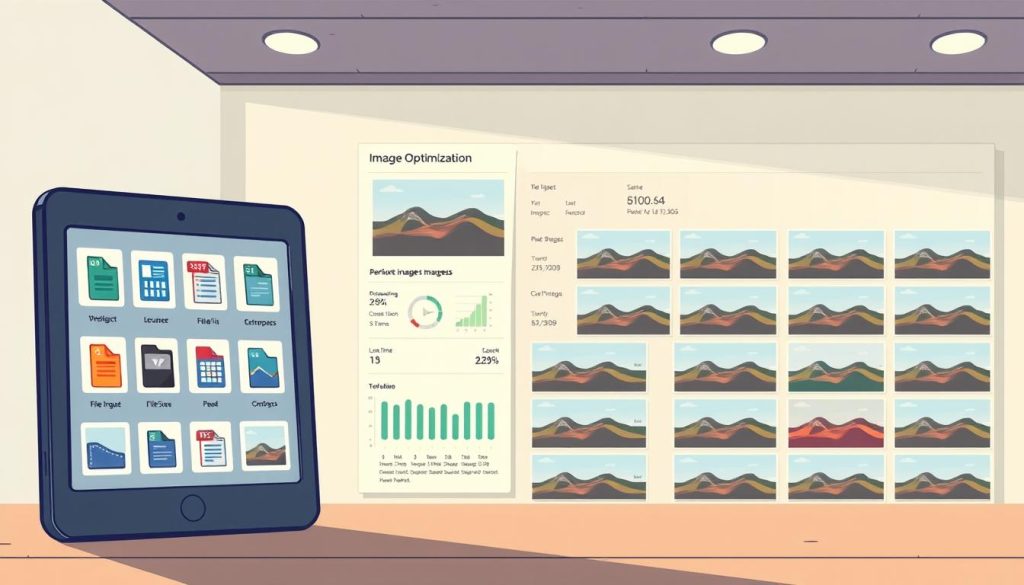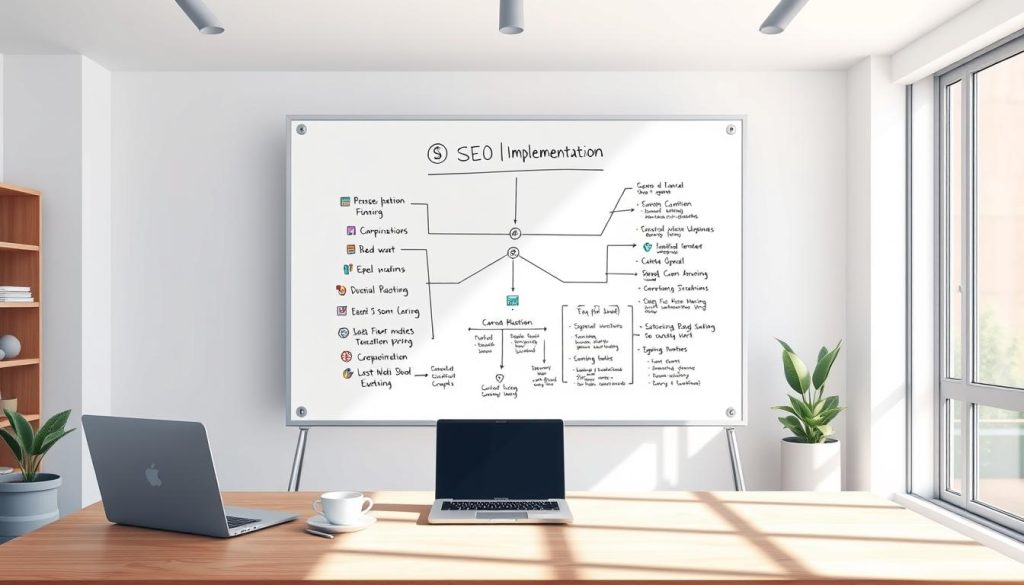Getting your website seen by search engines is key to online success. But, many beginners find on-page SEO best practices is really hard to start with.
To get better at search engine ranking, use simple yet powerful on-page methods. The right strategies can really boost your site’s performance.
We’ll look at the top 3 practices for beginners to improve their website’s ranking. By following these steps, you can make your online presence stronger.
Table of Contents
Main Objectives
- Optimize your website’s content for relevant keywords.
- Improve your website’s loading speed and mobile responsiveness.
- Use header tags to structure your content effectively.
- Enhance your website’s user experience with clear navigation.
- Regularly update your content to keep search engines crawling.
The Evolution of SEO in 2025
As we enter 2025, SEO is changing fast. Search engine algorithms are getting smarter. It’s key for newbies to know the big changes in SEO.
Key Algorithm Changes Affecting Rankings
The algorithms have changed a lot in 2025. They now focus more on user experience and content relevance. Websites need to be better and match what users want more closely.
| Algorithm Change | Impact on Rankings |
|---|---|
| Increased emphasis on user experience | Websites with poor UX will see a decline in rankings |
| Enhanced content relevance evaluation | More relevant content will rank higher |
Why Beginners Need to Focus on On-Page Factors
For beginners, on-page SEO factors are very important in 2025. You need to work on your content, meta tags, and links. This makes your site easier for search engines to find and better for users.
Essential On-Page SEO Best Practices for 2025
SEO is getting more complex, focusing on better on-page strategies. These strategies aim to please both search engines and users. The world of SEO is changing, with a big push towards modern SEO techniques.
The Shift from Traditional to Modern SEO Techniques
The SEO world is moving towards more advanced methods. Modern SEO techniques now use AI, voice search, and mobile-first designs. It’s key for newbies to keep up with these changes.
Setting Up Your SEO Toolkit as a Beginner
For beginners, getting the right tools is vital. An SEO toolkit should have both free and paid tools. This helps manage and improve on-page elements.
Free Tools Every Beginner Should Use
- Google Keyword Planner for keyword research tools
- Google Search Console for monitoring site performance
Paid Tools Worth the Investment
- Ahrefs for detailed backlink analysis and keyword research
- SEMrush for technical SEO audits and competitor analysis
Best Practice 1: Strategic Content Optimization
Strategic content optimization is key for good SEO in 2025. Search engines keep getting better, making high-quality, optimized content more important. We’ll look at the main parts of strategic content optimization. This includes keyword research, making valuable content, and improving headings and body text.
Researching and Selecting the Right Keywords
Good keyword research is the base of strategic content optimization. It’s about finding the terms and phrases your audience uses to find your content.
Using Keyword Research Tools Effectively
Use tools like Ahrefs, SEMrush, or Moz Keyword Explorer for keyword research. These tools show you search volume, competition, and related keywords.
Understanding Search Intent
Knowing search intent is key for picking the right keywords. Search intent is why someone searches for something. Are they looking for info, wanting to buy something, or going to a website? Matching your content with search intent makes it more relevant and can help it rank better.
Creating Valuable, Optimized Content
After finding your target keywords, create valuable, optimized content. This means making your content better for rankings and using keywords naturally.
Content Structure for Better Rankings
A good article has an intro, subheadings, and short paragraphs. Use subheadings to make your content easier to read and highlight important points.
Incorporating Keywords Naturally
Put your target keywords in your content naturally. Don’t stuff keywords, as it can hurt your rankings. Instead, focus on making content that’s easy to read and valuable.
Optimizing Headings and Body Text
Improving headings and body text is key for better visibility. Use descriptive, keyword-rich headings to help search engines understand your page’s structure and content.
| Optimization Technique | Description | Benefits |
|---|---|---|
| Keyword-rich headings | Use target keywords in headings | Improves content visibility and structure |
| Natural keyword incorporation | Incorporate keywords naturally throughout the content | Enhances readability and SEO |
| Content structuring | Use subheadings and concise paragraphs | Improves user experience and search engine understanding |
By using these strategic content optimization techniques, you can make your content more visible and improve its ranking.
Best Practice 2: Technical On-Page Elements

Technical on-page elements are key for a good website. They help with user experience and search rankings. We’ll look at title tags, meta descriptions, URLs, internal links, and image optimization.
Crafting Effective Title Tags and Meta Descriptions
Title tags and meta descriptions are important for SEO. They help search engines and users know what your page is about.
Title Tag Best Practices
- Keep title tags short, under 60 characters, for full display in SERPs.
- Put the main keyword at the start of the title tag.
- Make them catchy and descriptive to get more clicks.
Writing Click-Worthy Meta Descriptions
Meta descriptions should give a quick summary of your page. They should include keywords and a call to action.
- They should be 150-160 characters long.
- Use a friendly tone that speaks to your audience.
- Include a clear call-to-action, like “Learn more” or “Discover how.”
Optimizing URLs and Internal Link Structure
A good URL and internal linking can boost your SEO. Clear URLs help everyone understand your content.
Internal linking should be strategic. It makes your site easier to use and for search engines to crawl.
Image Optimization for SEO and Performance
Image Compression Techniques
Compressing images makes them smaller and faster to load. Tools like TinyPNG and ImageOptim help with this.
Alt Text and File Naming Conventions
- Use clear alt text with target keywords.
- Use a consistent naming style with keywords, like “keyword-description.jpg.”
By focusing on these technical aspects, beginners can improve their website’s SEO. This makes the site better for users and search engines.
Best Practice 3: User Experience and Page Performance
User experience and page performance go hand in hand for better rankings. Search engines now focus more on how users feel about a site. A good website keeps visitors longer, which means more people stay and do what you want them to.
Improving Core Web Vitals
Core Web Vitals measure how well a webpage works for users. They include:
Largest Contentful Paint (LCP)
LCP shows how fast the biggest part of a page loads. To improve LCP, make sure main content loads quickly. This can be done by optimizing images and using lazy loading.
First Input Delay (FID)
FID checks how fast a page responds to the first action. To better FID, reduce JavaScript’s impact on the main thread. This can be done by splitting code.
Cumulative Layout Shift (CLS)
CLS looks at how stable a page is visually. A low CLS score means elements don’t move around unexpectedly. This can be achieved by setting image sizes and using CSS aspect ratios.
Mobile Optimization Strategies
Most people use mobile devices to visit websites. So, making your site mobile-friendly is key. Use a responsive design, optimize images for different screens, and make sure content is easy to see on small screens.
Site Navigation and Structure
A well-organized website with easy navigation is better for users. Organize content in a clear order, use simple menu labels, and make sure visitors can find what they need.
By working on these areas, website owners can make their sites better for users and search engines. This will help improve their SEO.
Step-by-Step Implementation Guide for Beginners

Beginners should start with a week-by-week plan for SEO. This makes it easier and covers all important SEO points.
Week 1: Content Audit and Planning
The first step is a content audit. Look at your content to find what needs work. Use tools like Google Analytics and SEMrush to check how well your content does and find good keywords.
Week 2: Technical Optimization
In the second week, work on technical optimization. Make your site easier for search engines to find. Use tools like Google Search Console and Ahrefs to find and fix technical problems.
Week 3: User Experience Improvements
In the last week, focus on making your site better for users. Make pages load faster, navigation simpler, and content easy to find. Google’s Core Web Vitals report can help you see what to improve.
Following this plan, beginners can start strong with their SEO. They’ll make their website better and more effective.
Measuring Your On-Page SEO Success
To check if your on-page SEO is working, look at the right performance indicators and tools. It’s key to see how well your SEO is doing. This helps you know how to make your site more visible and ranked higher.
Key Performance Indicators to Track
Here are the main things to watch for your on-page SEO success:
- Organic traffic: Keep an eye on how many visitors find your site through search engines.
- Keyword rankings: See how your site ranks for the keywords you’re targeting.
- Click-through rate (CTR): Check how many people click on your site’s link in search results.
- Conversion rate: Look at how many visitors do what you want them to on your site.
Tools for Monitoring SEO Progress
Use these tools to keep track of your SEO progress:
- Google Analytics: Gives you details on your site’s traffic, how people engage, and conversions.
- SEMrush: Does technical SEO checks, tracks keywords, and looks at competitors.
- Ahrefs: Has tools for checking backlinks, researching keywords, and improving content.
By watching these key performance indicators and using the right SEO tools, you can really see how well your on-page SEO is doing. This helps you make smart choices to boost your strategy.
Conclusion
Effective on-page SEO strategies are key for beginners in 2025. Focus on optimizing content, technical elements, and user experience. This will boost your website’s search rankings and attract more visitors.
A good on-page SEO summary is about keyword research and optimizing title tags and meta descriptions. It also means improving core web vitals. By following these tips, you can build a strong online presence and stay competitive.
To keep improving your SEO, stay current with algorithm changes and best practices. Use tools like Google Analytics and Search Console to check your site’s performance. This helps you find and fix issues based on data.



